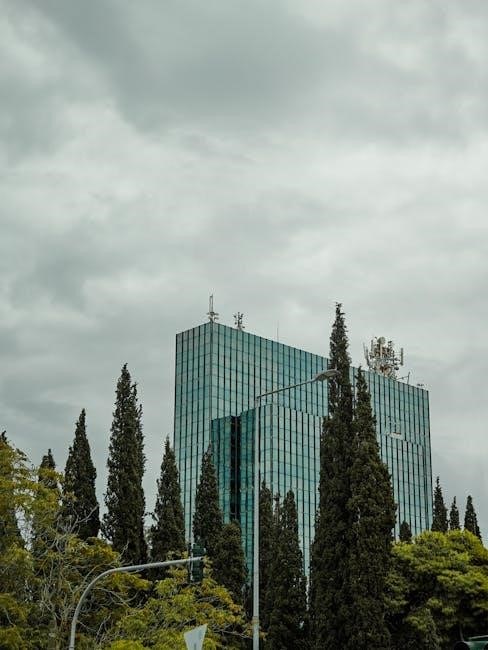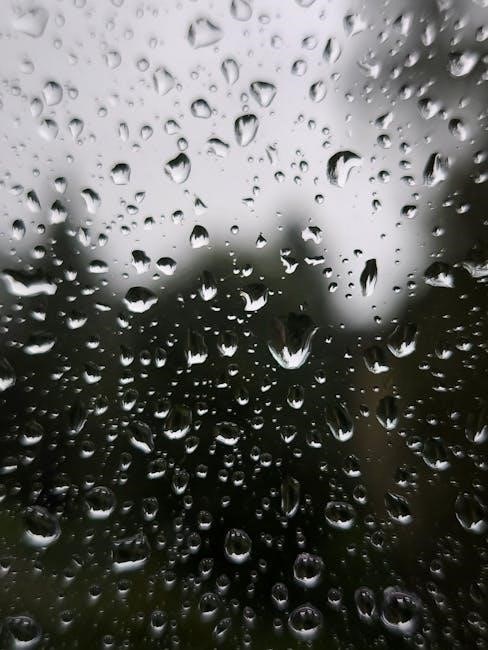
Glass is an amorphous, hard, brittle, and typically transparent material that is widely used in various applications due to its unique properties․ It is defined as a supercooled liquid with infinite viscosity, having no definite melting point․ Glass is primarily formed by fusing a mixture of metallic silicates or borates, such as sodium, potassium, calcium, or lead, with silicon dioxide (SiO2)․ This process results in a material that is both durable and versatile, making it indispensable in modern industries․
One of the key characteristics of glass is its transparency, which allows it to be used in windows, displays, and optical components․ Its chemical resistance and ability to withstand extreme temperatures further enhance its utility in laboratory equipment, cookware, and high-temperature applications․ Additionally, glass can be colored or treated to achieve specific properties, such as UV resistance or thermal insulation, expanding its range of uses․
The unique structure of glass, which lacks a crystalline arrangement, enables it to be molded into various shapes and forms․ This adaptability, combined with its aesthetic appeal, has made glass a cornerstone in both functional and decorative applications․ Its importance in modern society is undeniable, as it continues to play a critical role in technology, construction, and everyday life․
1․1 Definition and Overview
Glass is an amorphous, non-crystalline, and rigid material that is widely recognized for its transparency, durability, and versatility․ It is defined as a supercooled liquid with infinite viscosity, meaning it lacks a definite melting point and does not crystallize upon cooling․ Glass is primarily composed of silicon dioxide (SiO2), combined with other metallic oxides such as sodium oxide (Na2O), calcium oxide (CaO), and aluminum oxide (Al2O3), which are added to modify its properties․ This unique composition gives glass its characteristic hardness, brittleness, and resistance to chemical corrosion․
The most common type of glass, soda-lime glass, is made from a mixture of silica sand, soda ash (sodium carbonate), and limestone (calcium carbonate)․ This combination results in a material that is approximately 70-75% silica, 12-16% soda, and 8-12% lime․ The addition of soda ash reduces the melting temperature of silica, making it easier to produce, while limestone stabilizes the glass and prevents it from dissolving in water․ Soda-lime glass is the most prevalent type of glass used in windows, bottles, and other everyday applications due to its low cost and ease of production․
Beyond soda-lime glass, there are several other types of glass, each with distinct properties and uses․ Borosilicate glass, for example, contains boron trioxide, which increases its thermal resistance and makes it ideal for laboratory equipment, cookware, and medical devices․ Aluminosilicate glass, on the other hand, is known for its high chemical durability and is often used in electronic displays and touchscreens․ Quartz glass, which is nearly pure silica, is prized for its ability to withstand extreme temperatures and is used in high-temperature applications and UV light transmission․
Glass can also be classified based on its manufacturing process․ Float glass, for instance, is produced by floating molten glass on a bed of molten tin, resulting in a smooth, flat, and parallel surface․ This type of glass is widely used in architectural applications, such as windows, doors, and facades․ Laminated glass, which consists of multiple layers of glass bonded together with a plastic interlayer, is known for its safety features, as it remains intact even when broken․ Tempered glass, or toughened glass, is heat-treated to increase its strength and is commonly used in shower doors, vehicle windshields, and other applications where safety is a priority․
In addition to its functional uses, glass is also valued for its aesthetic appeal․ It can be colored, etched, or coated to achieve specific visual effects, making it a popular choice for decorative applications․ For example, stained glass is created by adding metallic salts to molten glass, resulting in vibrant colors that are often used in art and architecture․ Similarly, frosted glass, which has a matte finish, is used to create privacy in windows and doors while still allowing light to pass through․
Glass is also notable for its environmental benefits․ It is 100% recyclable, and recycling glass reduces energy consumption and raw material usage․ Additionally, glass is non-porous and inert, making it an ideal material for packaging food and beverages, as it does not react with its contents or allow them to spoil․ This property also makes glass a popular choice for laboratory equipment and medical storage․
1․2 Historical Background
The history of glass dates back thousands of years, with its origins rooted in ancient civilizations․ The earliest known glass objects were created around 2500 BC in Mesopotamia, where archaeologists have discovered small, opaque beads made from a mixture of silica and soda․ These early glass objects were not transparent but rather resembled glazed stones, indicating that the process of glassmaking was still in its infancy․

The art of glassmaking evolved significantly in ancient Egypt around 1500 BC․ Egyptians developed a more sophisticated method of producing glass, using silica-rich sand and soda, which they obtained from natural sources․ They created a variety of objects, including beads, amulets, and small vessels, often colored with metallic oxides to achieve vibrant hues․ Egyptian glass was highly valued for its beauty and durability, and it became a symbol of wealth and status․
The Romans further advanced glassmaking techniques, spreading the technology throughout their empire․ They discovered that by adding lime to the silica-soda mixture, glass became more stable and easier to melt․ This innovation led to the production of clearer glass, which was used for windows, cups, and other household items․ The Romans also developed blown glass, a revolutionary technique that allowed for the creation of hollow objects like bottles and jars․ This method involved inflating molten glass with a blowpipe, enabling the mass production of glassware․
Following the decline of the Roman Empire, glass production continued in the Byzantine Empire and the Islamic world․ During the Islamic Golden Age (8th to 13th centuries), glassmaking reached new heights․ Muslim artisans developed intricate glassware, including delicate vessels and ornate mosque lamps, often decorated with intricate designs and calligraphy․ They also experimented with new colors and techniques, such as lusterware, which involved applying metallic oxides to create a shimmering effect․
The art of glassmaking flourished in Venice during the Middle Ages, earning the city a reputation as the center of the glass industry․ Venetian glassmakers perfected the technique of cristallo, a clear, colorless glass that rivaled natural crystal․ They also developed intricate designs, such as filigree and millefiori, which became hallmarks of Venetian glass․ The secrets of Venetian glassmaking were closely guarded, and glassmakers were forbidden from sharing their knowledge outside the city․
The Industrial Revolution marked a significant turning point in the history of glass․ New manufacturing techniques, such as the cylinder process (1817) and the float glass process (1952), made it possible to produce large, flat sheets of glass inexpensively․ These innovations revolutionized architecture, enabling the construction of skyscrapers and modern buildings with extensive glass facades․ The development of tempered and laminated glass further expanded the applications of glass, making it safer and more durable for use in vehicles and other high-stress environments․
Today, glass is a ubiquitous material, used in everything from windows and bottles to electronic displays and medical equipment․ Its versatility and adaptability have made it an indispensable part of modern life․ Despite its ancient origins, glass continues to evolve, with researchers developing new types of glass, such as Gorilla Glass for smartphones and self-cleaning glass for architectural applications․ The history of glass is a testament to human ingenuity and the enduring quest to create materials that are both functional and beautiful․
1․3 Importance of Glass in Modern Applications
Glass has become an indispensable material in modern society, playing a crucial role in various industries and applications․ Its unique combination of transparency, durability, and versatility makes it a preferred choice for a wide range of uses, from construction and technology to healthcare and transportation․ The importance of glass in modern applications is evident in its widespread use and the significant impact it has on our daily lives․

Construction and Architecture
Glass is a cornerstone in modern architecture, revolutionizing the way buildings are designed and constructed․ Flat glass, such as float glass, is extensively used in windows, facades, and skylights, providing natural light and reducing the need for artificial lighting․ Laminated glass, which consists of multiple layers bonded together, offers enhanced safety and security, making it ideal for use in floors, staircases, and vehicle windshields․ Tempered glass, known for its strength and ability to shatter into small, blunt fragments, is widely used in shower doors, tabletops, and other applications where safety is a priority․
The use of glass in construction not only enhances the aesthetic appeal of buildings but also improves energy efficiency․ Low-emissivity (low-e) glass, for example, minimizes heat transfer, reducing energy consumption and lowering heating and cooling costs․ Insulated glass units (IGUs) with multiple panes further contribute to thermal insulation, making buildings more energy-efficient and environmentally friendly․
Technology and Electronics
Glass plays a vital role in the technology sector, particularly in the production of electronic displays and optical components․ Aluminosilicate glass, known for its high chemical durability and thermal resistance, is used in touchscreen devices, electronic displays, and optical fibers․ Quartz glass, composed of pure silicon dioxide, is ideal for high-temperature applications and is often used in laboratory equipment, UV light applications, and semiconductor manufacturing․
The development of advanced glass materials, such as Gorilla Glass, has revolutionized the smartphone industry․ This chemically strengthened glass is highly resistant to scratches and cracks, making it the preferred choice for mobile device screens․ Similarly, glass substrates are used in the production of flat-panel displays, including LCD and OLED screens, ensuring high-resolution imaging and vibrant colors․
Healthcare and Medical Applications
Glass is a critical material in the healthcare industry, where its chemical resistance, transparency, and durability make it ideal for medical equipment and packaging․ Borosilicate glass, for instance, is widely used in laboratory glassware, such as test tubes, beakers, and flasks, due to its ability to withstand extreme temperature fluctuations․ Its chemical inertness ensures that it does not react with laboratory chemicals, making it a reliable choice for scientific research․
In medical packaging, glass vials and ampoules are used to store pharmaceuticals, vaccines, and other sensitive medications․ Glass containers offer a sterile, non-reactive environment, preserving the integrity of the contents and ensuring patient safety․ Additionally, glass is used in medical devices, such as syringes and blood collection tubes, where its transparency and durability are essential for accurate and safe use․
Transportation
Glass is a key component in the automotive and aerospace industries, where safety, durability, and weight reduction are critical․ Laminated glass is used in windshields and side windows of vehicles, providing excellent impact resistance and preventing shattering in the event of an accident․ Tempered glass is used in rear windows and side mirrors, offering strength and safety at a lower cost․
In the aerospace industry, specialized glass materials are used in aircraft windshields and cockpit displays․ These glasses must withstand extreme conditions, including high altitudes, temperature fluctuations, and mechanical stress․ The use of advanced glass materials in transportation contributes to improved safety, fuel efficiency, and passenger comfort․
Sustainability and Environmental Applications
Glass is 100% recyclable, making it an environmentally friendly material․ Recycling glass reduces energy consumption, lowers greenhouse gas emissions, and conserves natural resources․ In addition, glass can be reused in various applications, such as insulation, aggregate, and decorative products, further reducing waste and promoting sustainability․
Glass is also used in renewable energy technologies, such as solar panels and windshields for solar thermal systems․ Its transparency and durability make it an ideal material for capturing and concentrating sunlight, enhancing the efficiency of solar energy systems․ Furthermore, glass is used in water treatment and filtration systems, where its chemical resistance and smooth surface prevent contamination and ensure clean water supply․

The importance of glass in modern applications cannot be overstated․ Its versatility, durability, and unique properties make it a vital material in construction, technology, healthcare, transportation, and environmental sustainability․ As research and development continue to advance, new types of glass with enhanced properties are being created, further expanding its potential uses․ From the windows of skyscrapers to the screens of smartphones, glass plays a pivotal role in shaping modern society and improving our quality of life․
As we look to the future, the continued innovation in glass technology promises to unlock new possibilities, driving progress in various industries and contributing to a more sustainable and connected world․ The enduring importance of glass is a testament to its timeless value and its ability to adapt to the changing needs of humanity․

Types of Glass
Glass is a versatile material that can be manufactured in various forms, each with distinct properties and applications․ The different types of glass are categorized based on their chemical composition, manufacturing process, and intended use․ Understanding these types is essential for selecting the right glass for specific applications, whether in construction, technology, healthcare, or everyday products․
Soda-Lime Glass
Soda-lime glass is the most common type of glass, accounting for approximately 90% of all glass produced․ It is made from a mixture of silicon dioxide (SiO2), sodium oxide (Na2O), and calcium oxide (CaO)․ This type of glass is relatively inexpensive to produce and is widely used in windows, bottles, jars, and light bulbs․ Soda-lime glass is known for its transparency, chemical resistance, and ability to be colored or coated for specific applications․
One of the key advantages of soda-lime glass is its versatility․ It can be annealed, tempered, or laminated to enhance its strength and safety․ Annealed glass is the basic form, while tempered glass is heat-treated to increase its strength and make it safer in case of breakage․ Laminated soda-lime glass, on the other hand, is layered with a plastic interlayer to hold the glass together if it shatters, making it ideal for automotive windshields and safety applications․
Borosilicate Glass
Borosilicate glass is another popular type of glass, known for its excellent thermal resistance and chemical durability․ It is made by adding boron trioxide (B2O3) to the glass formula, which reduces thermal expansion and makes it resistant to thermal shock․ This type of glass is widely used in laboratory equipment, cookware, and medical devices, where exposure to extreme temperature changes is common․
Borosilicate glass is also used in the production of pharmaceutical packaging, such as vials and ampoules, due to its non-reactive properties․ Its transparency and resistance to chemicals make it an ideal choice for applications where purity and durability are critical․ Additionally, borosilicate glass is used in high-quality lighting fixtures and optical components, where its thermal stability and clarity are essential․
Aluminosilicate Glass
Aluminosilicate glass is a type of glass that contains aluminum oxide (Al2O3) in addition to silicon dioxide and other metal oxides․ This type of glass is known for its high chemical durability and thermal resistance, making it suitable for applications where exposure to harsh environments is expected․ Aluminosilicate glass is used in electronic displays, touchscreen devices, and optical components, where its strength and resistance to scratches are advantageous․
One of the unique properties of aluminosilicate glass is its ability to withstand high temperatures without losing its shape or clarity․ This makes it an excellent choice for use in high-temperature environments, such as in industrial furnaces and aerospace applications․ Additionally, aluminosilicate glass is used in the production of flat-panel displays and solar panels, where its thermal stability and optical clarity are essential;
Quartz Glass
Quartz glass, also known as fused silica, is made from pure silicon dioxide (SiO2) that is melted and cooled to form a glass-like material․ This type of glass is known for its exceptional thermal stability, chemical resistance, and optical clarity․ Quartz glass is widely used in high-temperature applications, such as in laboratory equipment, UV light applications, and semiconductor manufacturing․
One of the key advantages of quartz glass is its ability to withstand extreme temperatures without losing its shape or clarity․ It is also highly resistant to chemical corrosion, making it an ideal choice for use in harsh environments․ Quartz glass is used in the production of optical fibers, UV lamps, and high-temperature furnaces, where its unique properties are essential for performance and durability․

Float Glass
Float glass is a type of soda-lime glass that is produced using the float glass process, where molten glass is floated onto a bath of molten tin․ This process results in a smooth, flat, and parallel surface, making it ideal for use in windows, mirrors, and other applications where optical clarity is important․ Float glass is the most common type of glass used in architectural applications, including windows, doors, and facades․
Float glass can be further processed to enhance its properties․ For example, it can be tempered to increase its strength, laminated to improve safety, or coated to reduce heat transfer․ These modifications make float glass suitable for a wide range of applications, from residential windows to commercial skylights and storefronts․
Laminated Glass
Laminated glass is a type of safety glass that consists of multiple layers of glass bonded together with a plastic interlayer․ This construction makes laminated glass highly resistant to impact and penetration, as the interlayer holds the glass fragments together if the glass is broken․ Laminated glass is widely used in automotive windshields, skylights, and architectural glazing, where safety and security are critical․
One of the key advantages of laminated glass is its ability to reduce noise and UV radiation․ The interlayer can be designed to block UV rays and reduce sound transmission, making laminated glass an excellent choice for use in noise-sensitive environments․ Additionally, laminated glass is used in bulletproof applications, where its ability to withstand impact is essential for protecting people and property․

Tempered Glass
Tempered glass, also known as toughened glass, is a type of safety glass that is heat-treated to increase its strength and make it safer in case of breakage․ Tempered glass is made by heating the glass to a high temperature and then rapidly cooling it, a process known as quenching․ This process makes the glass up to five times stronger than annealed glass and causes it to shatter into small, blunt fragments if broken․
Tempered glass is widely used in applications where safety is a priority, such as in shower doors, tabletops, and architectural glazing․ It is also used in automotive side windows and rear windshields, where its strength and safety features are essential․ Tempered glass is an excellent choice for use in high-traffic areas, where the risk of breakage is higher and safety is a concern․

Specialty Glasses
In addition to the common types of glass, there are several specialty glasses that are designed for specific applications․ These include fused silica glass, which is made from pure silicon dioxide and is known for its exceptional thermal stability and optical clarity; lead crystal glass, which contains lead oxide and is prized for its brilliance and weight; and tinted glass, which is colored by adding metal oxides or other compounds to the glass formula․

Other types of specialty glass include reflective glass, which is coated with a reflective layer to reduce glare and heat transfer; insulated glass, which consists of multiple panes separated by a gas-filled space to improve thermal insulation; and decorative glass, which is designed for aesthetic purposes and can be etched, painted, or textured to create unique designs․

The various types of glass offer a wide range of properties and applications, making glass a versatile and essential material in modern society․ From the common soda-lime glass used in windows and bottles to the specialized borosilicate and quartz